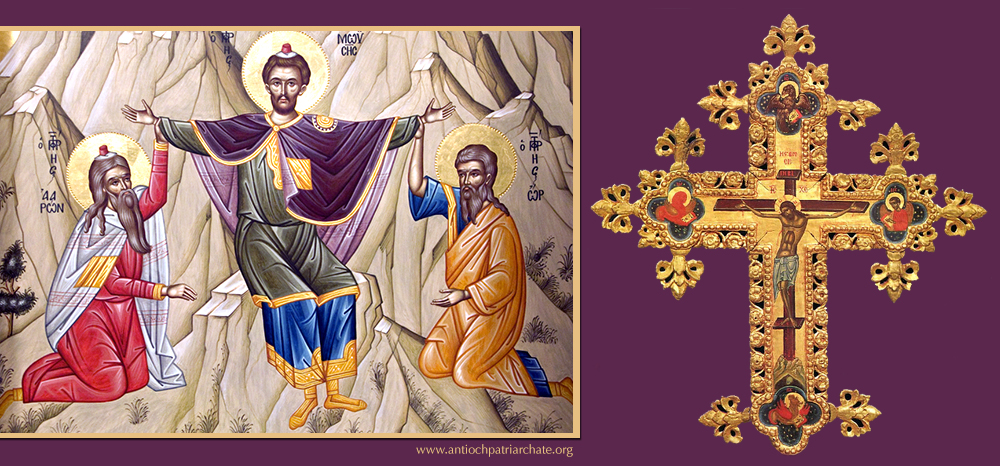
The Cross from the Old Testament to the New…
The Cross from the Old Testament to the New Testament
This icon represents a scene from Exodus in the Old Testament
(chapter 17). It is linked directly to the life-giving Cross, that is, to the work of salvation which has been fulfilled by the Lord on the Cross. ![]()
“And Moses said to Joshua, “Choose us some men and go out, fight with Amalek. Tomorrow I will stand on the top of the hill with the rod of God in my hand.” So Joshua did as Moses said to him, and fought with Amalek. And Moses, Aaron, and Hur went up to the top of the hill. And so it was, when Moses held up his hand, that Israel prevailed; and when he let down his hand, Amalek prevailed. But Moses’ hands became heavy; so they took a stone and put it under him, and he sat on it. And Aaron and Hur supported his hands, one on one side, and the other on the other side; and his hands were steady until the going down of the sun”. (Exodus 17: 9-12)
Before explaining that incident, we must assert that many images in the Old Testament point to the Lord Jesus Christ the Savior and people are amazed when they get their meaning.
From here comes the Lord’s statement to the teachers of the Jews: “You search the Scriptures for in them you think you have eternal life; and these are they which testify of me” (John 5:39).
The feasts of the Lord Jesus in the Orthodox Church are all interrelated. They all stem from the economy of salvation which God foretold from the first page of Genesis. The One who IS from Eve’s offspring, who will crash the head of the serpent, IS Jesus. The One whose ankle the serpent is going to lick IS also Jesus. This is a clear sign of the cross; I mean that the Lord is going to be crucified.
“He shall bruise your head and you shall be on guard for his heel” (Genesis 3:15).
On the day of the Annunciation the church sings:
Today is the beginning of our salvation, and the manifestation of the mystery from the ages; for the Son of God becometh the Son of the Virgin, and Gabriel proclaimeth grace. Wherefore, do we shout with him to the Theotokos, Hail, O full of grace. The Lord is with thee.
God was incarnate and became a human being. Prophesies have been told about him and were fulfilled in Him. That is why the Lord said from the cross: “It has been accomplished” (John 19:30).
The explanation of the text on the icon:
1- Exodus 17 starts saying:
“Now all the congregation of the children of Israel departed from the wilderness of Sin, according to their encampments and by the word of the Lord and camped in Rephidim; but there was no water for the people to drink (Exodus 17:1).
- The word “Rephidim means a wide place. The suffix “im” in Hebrew is for the plural form.
- According to their encampments means the stages of their path in the wilderness and the places they stopped at (Number 33:12).
- The lesson:
The road to Rephidim is long and hard and many rest points are needed especially because the weather is too hot. They needed water to drink and it was not available.
This is what also occurs to us every day. Our road in life is too long and hard before we can reach our eternal rest with the Lord especially if we wish to stay faithful to the word of the Gospel and to reach holiness.
We encounter many difficulties by which we are tested. We need the water of life to drink and be strengthened. Shall God leave us orphans?
Let us continue and see.
2- “Therefore the people contended with Moses saying “Give us water that we may drink.” Moses then said to them, “why do you contend with me? Why do you tempt the Lord?” Thus the people there thirsted for water and then complained against Moses and said, “Why is it you brought us up out of Egypt to kill us and our cattle with thirst?” (Exodus 17:1-4).
![]()
Here the fear of death prevails and weakness is in control of all the people; it is what urges them to complain; it spreads the spirit of quarrel and contention among them.
- The lesson:
This occurs during temptations and calamities, especially when we lose confidence in the Lord. The first verse in the biblical text states clearly that their stay at Rephidim was by the word of God. Did God deceive them? God forbid.
3- “Then Moses cried to the Lord and said, “what do I do with this people?
In a while they will stone me. The Lord said to Moses, “walk before them taking some of the elders of Israel with you. The rod with which you hit the river, take it and go. I stand before you on the rock of Horeb, you hit the rock and water comes out for the people to drink. So did Moses before the eyes of the elders of Israel” (5-6).
The rock is Christ himself: “All ate the same spiritual food and all drank the same spiritual drink. For they drank of that spiritual Rock that followed them, and that rock was Christ” (1 Corinthians 10:3).
“The Lord then spoke to Moses saying, “take the rod: and you and your brother Aaron gather the congregation together. Speak to the rock before them and it will give its waters; thus you shall bring them water out of the rock” (Numbers 20:7).
Moses hitting the rock is an early image of the crucifixion of Jesus Christ and His sufferings for our sake; it is also an early image of the lance with which He was stabbed in the side, when water and blood came out.
-Important note:
The blood sacrifice on the cross was accomplished once, and we do not celebrate a new one: “Knowing that Christ having been raised from the dead dies no more. Death no longer has dominion over him” (Romans 6:9-10).
That is why we call the Divine Liturgy the “bloodless sacrifice”: “…again we offer unto thee this reasonable and bloodless sacrifice and we beseech and implore thee, and offer our supplications unto thee, that thou shalt send thy Holy Spirit upon us, and upon these gifts here spread forth”.
Moreover, the Lord did not bring down rain upon the people, so that they would think it is an ordinary phenomenon, but He rather wished to declare His power and might, so that they would understand that He is the one who takes good care and looks after each one of them.
- The lesson:
This incident places before us what the Lord Himself said: “On the last day that great day of the feast Jesus stood and cried out saying, “if anyone thirsts let him come to me and drink. He who believes in me as the scriptures has said, out of his heart will Flow Rivers of living waters”. But this He spoke concerning the spirit whom those believing in him would receive for the Holy Spirit was not yet given because Jesus was not yet glorified” (John 7:37-40).
• The goal of the Christian life is the acquisition of the Holy Spirit (St. Seraphim of Sarov).
“So he called the name of the place Massah and Meribah, because of the contention of the children of Israel, and because they tempted the Lord, saying, “Is the Lord among us or not? (Exodus 17:7)
Massah and Meribah mean temptation.
- The Lesson:
![]() How many times do we doubt the presence of God? How many times do we falter and say, “why have you abandoned us, God?
How many times do we doubt the presence of God? How many times do we falter and say, “why have you abandoned us, God?
Is God with us or not? We forget that God does not tempt any one, but rather allows temptations to befall us for the salvation of our souls and also for us to be humble.
“Let no one say when he is tempted, “I am tempted by God”; for God cannot be tempted by evil, nor does he himself tempt any one. But each one is tempted when he is drawn away by his own desires and enticed (James 1:13-14).
“And Amalek came and fought Israel in Raphidim” (Exodus 17:8).
This is the first open war waged with the Hebrew people after crossing the sea. The army of Egypt drowned in the water: “Stand up and see the salvation of the Lord…. The Lord will fight for you and you shall hold your peace” (Exodus 14:14).
Amalek is the generation of Amalek Son of Eliphaz Son of Esau: “Remember what Amalek did to you on the way as you were coming out of Egypt. How he met you on the way and cut off your rear guard, all the stragglers at your rear, when you were tired and weary; and he did not fear God” (Deuteronomy 25:17-18).
- The lesson:
Our first enemy is the Devil. He takes hold of the reckless and the indolent: “Be watchful. Be vigilant; because your adversary the Devil walks about like a roaring lion seeking whom he may devour” (1 Peter 5:8-9).
The Pharaoh of Egypt did not drown in the sea, he was just defeated, exactly like the devil who was overcome by the Cross, and still he tempts humans. He is the first tempter and the accuser until the last day.
This might seem weird and strange, yet it is the means of our salvation, for the holy fathers assure and say, “Take away temptations and no one shall be saved”. Our fight with Amalek the devil never stops and we can beat him only by the One who was Crucified.
6- “Moses said to Joshua, “choose some men and go out to fight Amalek. Tomorrow I shall stand on top of the hill with the rod of God in my hand. Joshua did as he was told by Moses to fight Amalek. And Moses, Aaron, and Hur went up the hill. And when Moses would lift his hand Israel won, and when he took it down he was defeated. And when Moses’ hands became heavy they took a stone and laid it under him and he sat on it. And Aaron and Hur supported his hands one from here and the other from the other side so his hands would not move until the going down of the sun. And so Amalek was defeated by the sword” (v. 9-13).
-The name Joshua is Jesus, and it means God saves. The name consists of two parts: “YHWH” from the verb to be. Thus it means “the One who is”. And Shah means “he saves”.
-Joshua is the one who led the people after the death of Moses the prophet. Joshua would fight while Moses stood on top of the hill to pray while the rod of God was in his hand (and this denotes the power of God).
-Here we see Moses standing with his hands stretched out in the form of a cross.
-The people had complained earlier against Moses and now they testify that, by his prayer with the hands up, Moses will save them from inevitable death, and that victory is not their by their own hand.
-Moses on top of the hill is accompanied by both Aaron and Hur.
Aaron is the archpriest and Hur is Mariam’s husband and the grandfather of Bezalel from the tribe of Judea (Exodus 31:3), (1 chronicles 2:3-20).
The Lord Jesus Christ is the King of kings and the Greatest Archpriest.
-Until sunset:
The hands of Moses were steady until the going down of the sun and they conquered the enemy and achieved victory.
Christ stayed on the cross from the 6th to 9th hours according to Roman time, which is from around 12 to 3 pm, i.e., until before sunset.
Hence, the Gospel saying: “Now from the sixth hour until the ninth hour there was darkness over all the land.” (Matthew 27:45) The 9th hour (3pm) then is the hour when the Lord Jesus Christ descended into Hades and conquered Satan. (See the prayers of the 9th hour in the Book of Hours- Horologion).
The lesson:
“And I looked, and behold, a white horse. He who sat on it had a bow; and a crown was given to him, and he went out conquering and to conquer. (Revelation 6:2) The Crucified One is the Victorious One. The Lord says: “I am the vine, you are the branches. He who abides in Me, and I in him, bears much fruit; for without Me you can do nothing.” (John 15:5)
This is also confirmed by the Apostle James in his epistle: “Therefore submit to God. Resist the devil and he will flee from you. (James 4:7).
7- “God said to Moses, “write this for a memorial in a book and recount it in the hearing of Joshua that I will utterly blot out the remembrance of Amalek from under heaven. Now Moses built an altar and called its name “the-Lord-My-Refuge”; for with secret hand the Lord wars with Amalek from generation to generation” (v.14-16).
- The lesson:
The devil fell down from heaven forever. That is what the Lord Jesus Christ said to the 70 apostles when they returned with joy because signs and miracles have been made by them and the devil itself has been defeated in the name of Jesus. “And the 70 apostles returned with joy saying, “Lord even the demons are subject to us in Your name. And He said to them "I saw Satan fall like lightning from heaven” (Luke 10:17-18).
-“Jehovah nissi”. The expression means the Lord is my flag and banner; the Lord is my victory.
-The hand on the chair of the Lord:
The war of the devil is against the church and against us. In fact, it is a war waged against the Lord himself, for the Church is His body and He is its head. We are the temples of the Holy Spirit. It is a war fully violent from one generation to generation, but those armed with the power of the Lord Jesus Christ, will triumph and win.
![]()
Conclusion:
When two armies meet and clash the winner fixes his banner and flag on the land of the defeated party, and erects it in sign of triumph and victory.
Our banner is the cross; it is the sign of victory which the Lord fixed in the middle of Hades so as to declare victory over death.
This is what this beautiful icon represents and stands for.

2024-07-24
2024-07-21
Patriarch John X from Saint…
2024-07-20
2024-07-17
2024-07-15
Celebrating the Feast of Holy…







